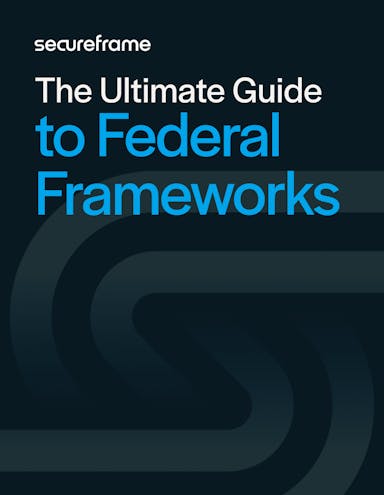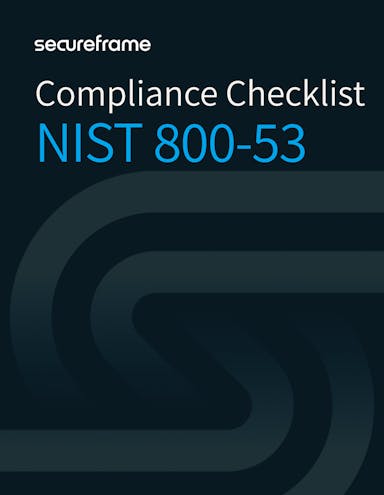Knowing what the NIST 800-53 security requirements are is one thing, but putting them into practice is another. With hundreds of controls, multiple impact levels, and control enhancements to consider, actually achieving compliance with the framework can feel overwhelming.
Let’s break it down step-by-step to help you navigate the process, from defining scope and choosing the right controls to maintaining compliance over time.
Step 1. Define the scope of your information systems
Clearly defining what’s in scope helps you apply the right security controls and avoid wasted effort on things that don’t need protection.
Start by listing all systems, applications, databases, and network components that process sensitive information. Then identify data flows (where data is created, stored, processed, and transmitted), and map out who uses them, how they connect, and where they’re located (on-premises, cloud, hybrid, etc.).
With this information, you can determine which laws, regulations, and internal policies apply.
Step 2: Understand NIST 800-53 control families
NIST 800-53 Revision 5, “Security and Privacy Controls for Federal Information Systems and Organizations,” outlines more than 1,000 security and privacy controls designed to protect federal systems. These controls are grouped into 20 control families, each covering a critical aspect of security and compliance.
Together, these control families form the foundation of a strong security posture, addressing everything from user access and physical security to risk management and compliance requirements. It’s important to note that control families are arranged alphabetically according to their identifiers, not in order of importance or the order in which controls should be implemented.

Within each control family, NIST 800-53 outlines specific controls designed to protect information systems, manage privacy risks, and meet compliance requirements.
These security controls fall into three main categories:
- Technical safeguards: Security measures like data encryption, firewalls, and network segmentation, which protect data and systems from cyber threats.
- Administrative safeguards: Security awareness training and incident response planning ensure employees know how to recognize threats and respond effectively.
- Physical safeguards: Restricted access areas, security screenings, guards, and locks keep unauthorized individuals from physically accessing sensitive systems.

The Ultimate Guide to Federal Frameworks
To address an increasingly complex and dangerous threat landscape, the US government has created several information security standards and frameworks for reducing risk and improving data security. Get an overview of the most common federal frameworks, who they apply to, and what their requirements are.
Step 3: Conduct an impact analysis to define your NIST 800-53 impact level and control baseline
Now, here’s where it gets a little more complicated. Implementing all 1,186 NIST 800-53 security controls would not only be very resource intensive, but also probably overkill. Luckily, NIST 800-53 compliance doesn’t require organizations to implement every control, only the ones needed to secure their information systems. The challenge is figuring out which ones make the most sense for your organization’s unique security and privacy risks.
To make things easier, NIST provides control baselines, which are essentially a starting point for selecting the right security controls based on risk. Organizations begin by using FIPS 199 to define their system’s impact level and associated control baseline, and then customize that set of controls based on their specific compliance needs and risk environment.
There are four control baselines total: three security baselines, based on low, moderate, and high impact levels; and one privacy baseline, which applies to any system that processes Personally Identifiable Information (PII).
The three security baselines are based on how severe the consequences would be if the system were compromised. Impact level is determined by two key factors: first, how sensitive and critical the data is being processed, stored, or transmitted. And second, the potential damage if there’s a loss of confidentiality, integrity, or availability (i.e., a data breach, unauthorized system access, or service disruption).
Each baseline comes with a different set of required security controls:
- Low-impact baseline: Used for systems where a security breach would cause limited harm. This has the fewest controls and is considered the least stringent.
- Moderate-impact baseline: Applied to systems where a breach could cause serious harm. These require more controls to mitigate higher risks.
- High-impact baseline: Reserved for systems where a breach could have severe or catastrophic consequences, such as critical infrastructure, national security, or major financial data. These require the most stringent security controls.

Let’s look at a real example to see how control baselines impact which security measures an organization must implement. Say we’re looking at the Access Control (AC) family, which deals with who can access sensitive information, under what conditions, and how that access is managed.
If an organization follows the low security baseline, they must implement:
- AC-1 Policy and Procedures
- AC-2 Account Management
- AC-3 Access Enforcement
- AC-7 Unsuccessful Login Attempts
- AC-8 System Use Notification
- AC-14 Permitted Actions without Identification or Authentication
- AC-17 Remote Access
- AC-18 Wireless Access
- AC-19 Access Control for Mobile Devices
- AC-20 Use of External Systems
- AC-22 Publicly Accessible Content
If an organization follows the moderate security baseline, they must implement everything above, plus:
- AC-4 Information Flow Enforcement
- AC-5 Separation of Duties
- AC-6 Least Privilege
- AC-11 Device Lock
- AC-12 Session Termination
- AC-21 Information Sharing
If an organization follows the high security baseline, they must implement everything above, plus:
- AC-10 Concurrent Session Control
Each time you move up in impact level, the number of required controls increases because the potential consequences of a breach get more serious.
Unlike security baselines, the privacy control baseline isn’t tied to impact levels. If an organization’s system handles PII, it must implement all of the privacy requirements.

NIST 800-53 Compliance Checklist
With over a thousand controls, NIST 800-53 is a strict and comprehensive information security framework. Use this checklist as a structured approach for evaluating your compliance with NIST 800-53 requirements and overall cybersecurity posture.
Step 4. Complete a risk assessment to identify and prioritize threats
Not all risks are equal — some require immediate action, while others may be acceptable risks. A risk assessment helps you prioritize security efforts and avoid unnecessary spending on low-risk threats.
Use the NIST Risk Management Framework (RMF) to guide your risk assessment. You’ll identify potential threats and vulnerabilities that could impact the information systems you defined as in scope in step 1, such as cyberattacks, insider threats, data leaks, system failures, and supply chain risks. Assess the likelihood and potential impact of each threat, then rank risks based on which ones pose the biggest threats to your systems and organizational operations.
Recommended reading

How to Conduct a Risk Assessment for NIST 800-53 Compliance + Templates
Read MoreStep 5. Tailor baseline security controls based on risk assessment results
Baseline controls are not one-size-fits-all. Tailoring your control selection process ensures you’re applying the right security measures without unnecessary complexity.
Start with the NIST 800-53 baseline security controls that match your impact level, then adjust these controls based on specific risks from your risk assessment. This may mean adding enhancements or removing unnecessary controls. Be sure to factor in residual risk (any risk that remains even after controls are applied) and align with your organization’s risk tolerance.
Step 6. Implement controls and control enhancements
Time to roll up your sleeves and integrate your control selections into your technology, processes, and everyday operations. This could mean implementing technical measures (like firewalls and encryption), administrative policies (like incident response and business continuity plans), and physical security (like access badges).
Control enhancements are add-ons to base controls that provide additional security, strengthen protections, or address more complex risks. Think of them as extra security features you can enable when a standard control isn't enough for your organization's needs.
For example, the Access Control (AC) family includes the base control AC-2 (Account Management), which requires organizations to manage user accounts. But there are 17 control enhancements under AC-2 that add additional safeguards, including:
- AC-2(4) Automated System Account Management: Automating account creation, disablement, and removal.
- AC-2(12) Account Monitoring and Atypical Usage: Monitoring user activity for unusual patterns.
- AC-2(13) Disable Accounts After Expiration: Automatically disabling accounts when they expire.
So how do you know if you need to implement control enhancements?
First, check your baseline. If you’re following NIST 800-53 Low, Moderate, or High baselines, some control enhancements may already be required at your impact level. Higher-impact systems require more enhancements because they face greater risks.
Next, consider your risk level. If you handle sensitive or classified data, process high-value transactions, or operate mission-critical systems, you may need additional enhancements beyond your baseline. Use your risk assessments to determine if standard controls provide enough protection or if enhancements are needed.
Lastly, verify industry or regulatory compliance requirements. Some federal regulations such as FISMA, HIPAA, CMMC, and FedRAMP may require specific enhancements beyond the baseline controls. If a customer, auditor, or regulator requires stronger security measures, you may need to implement extra enhancements to stay compliant.
As an example, let’s say your organization follows the Moderate security baseline. For Access Control (AC-2), the base control requires you to manage user accounts, but the control enhancement AC-2(12) Account Monitoring and Atypical Usage isn’t required at this level.
However, during your risk assessment, you discover that employees sometimes access systems outside business hours, and a recent phishing attack resulted in unauthorized login attempts. The standard AC-2 control doesn’t address these risks, so you implement AC-2(12) to help you track account usage and better detect and prevent suspicious activity.
Add control enhancements if your risk assessment shows you need stronger protections beyond the baseline controls. You’ll also need to ensure privacy controls are applied if your system processes PII. Train employees on new security policies and procedures to ensure everyone across your organization is informed and aligned on any new security measures or changes to existing processes.
Step 7. Monitor and assess control performance
If you don’t monitor your controls, you won’t know if they’re failing until it’s too late. Setting up continuous monitoring will allow you to assess how well your security controls are performing over time and flag any failing controls or misconfigurations.
Conduct regular vulnerability scans, penetration tests, and security audits to detect weaknesses and assess whether controls are working as intended or need improvements.
Step 8. Maintain required documentation
If an auditor, regulator, executive, or other stakeholder asks, “How are you protecting your systems?” you need to show clear documentation of your security measures. You’ll need to document all implemented security controls in a System Security Plan (SSP), and maintain a Plan of Action and Milestones (POA&M) to track any unresolved security issues and how they’re being addressed. It’s also important to keep detailed records of any internal audits, security assessments, and incident response activities.
Recommended reading

The Policies and Procedures You Need for NIST 800-53 Compliance + 11 Templates to Get You Started
Read MoreAutomating NIST 800-53 compliance
NIST 800-53 might seem overwhelming, but you don’t have to do it all manually. Security and compliance automation tools can streamline control implementation, monitoring, and reporting, helping you stay secure and compliant without as much manual work. In fact, our platform helps companies get compliant with NIST 800-53 up to 70% faster.
Learn more about how Secureframe can help you get compliant with NIST 800-53, NIST 800-171, CMMC 2.0, NIST Cybersecurity Framework 2.0., and dozens of other security standards by scheduling a demo today.
Streamline your NIST 800-53 compliance
FAQs
What are the NIST 800-53 requirements?
NIST 800-53 requirements are a comprehensive set of security and privacy controls designed to protect federal information systems from cybersecurity risks. These requirements cover areas like access control, risk assessment, incident response, encryption, and continuous monitoring. Organizations use NIST 800-53 control baselines to determine which security measures they need based on their system’s impact level.
What is NIST 800-53 in a nutshell?
NIST 800-53 is a security framework developed by the National Institute of Standards and Technology (NIST) to help the federal government and its service providers implement strong cybersecurity protections. It defines 1,000+ security and privacy controls across 20 control families.
What is the NIST 800-53 compliance assessment?
A NIST 800-53 compliance assessment evaluates whether an organization’s security controls align with the framework’s requirements for federal information systems. The assessment process typically involves reviewing documentation, testing control effectiveness, and identifying any security gaps. Organizations undergoing federal security audits (e.g., FISMA or FedRAMP assessments) must demonstrate compliance with NIST 800-53.
What are the NIST 800-53 password requirements?
NIST 800-53 password complexity requirements focus on strong authentication while reducing password fatigue. Requirements align with NIST SP 800-63B:
- Minimum length of 8 characters
- Allowing the use of passphrases
- Banning commonly used, easily guessed passwords
- No mandatory periodic password changes unless evidence of a compromise
- Multi-factor authentication (MFA)
What are the NIST 800-53 MFA requirements?
NIST 800-53 MFA requirements include MFA for privileged users, protecting remote access, and using at least two authentication factors, such as:
- Something you know (password or PIN)
- Something you have (smart card, security key)
- Something you are (fingerprint, facial recognition)
What are the NIST 800-53 audit logging requirements?
NIST 800-53 requires organizations to implement audit logging to track user activity, system events, and security incidents. Key requirements include:
- Logging all significant security events, including logins, access attempts, and configuration changes
- Ensuring logs are tamper-resistant and protected from unauthorized access
- Storing audit logs for a defined retention period to support investigations
- Using automated tools to analyze logs for suspicious activity
- Ensuring logs are synchronized with an accurate time source